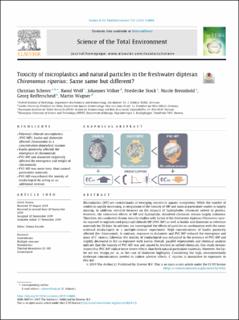| dc.contributor.author | Scherer, Christian | |
| dc.contributor.author | Wolf, Raoul | |
| dc.contributor.author | Völker, Johannes | |
| dc.contributor.author | Stock, Friederike | |
| dc.contributor.author | Brennhold, Nicole | |
| dc.contributor.author | Reifferscheid, Georg | |
| dc.contributor.author | Wagner, Martin | |
| dc.date.accessioned | 2020-07-01T10:08:07Z | |
| dc.date.available | 2020-07-01T10:08:07Z | |
| dc.date.created | 2020-01-16T11:35:52Z | |
| dc.date.issued | 2020 | |
| dc.identifier.citation | Science of the Total Environment. 2020, 711, 134604. | en_US |
| dc.identifier.issn | 0048-9697 | |
| dc.identifier.uri | https://hdl.handle.net/11250/2660277 | |
| dc.description.abstract | Microplastics (MP) are contaminants of emerging concern in aquatic ecosystems. While the number of studies is rapidly increasing, a comparison of the toxicity of MP and natural particulate matter is largely missing. In addition, research focusses on the impacts of hydrophobic chemicals sorbed to plastics. However, the interactive effects of MP and hydrophilic, dissolved chemicals remain largely unknown. Therefore, we conducted chronic toxicity studies with larvae of the freshwater dipteran Chironomus riparius exposed to unplasticised polyvinyl chloride MP (PVC-MP) as well as kaolin and diatomite as reference materials for 28 days. In addition, we investigated the effects of particles in combination with the neonicotinoid imidacloprid in a multiple-stressor experiment. High concentrations of kaolin positively affected the chironomids. In contrast, exposure to diatomite and PVC-MP reduced the emergence and mass of C. riparius. Likewise, the toxicity of imidacloprid was enhanced in the presence of PVC-MP and slightly decreased in the co-exposure with kaolin. Overall, parallel experiments and chemical analysis indicate that the toxicity of PVC-MP was not caused by leached or sorbed chemicals. Our study demonstrates that PVC-MP induce more severe effects than both natural particulate materials. However, the latter are not benign per se, as the case of diatomite highlights. Considering the high, environmentally irrelevant concentrations needed to induce adverse effects, C. riparius is insensitive to exposures to PVC-MP. | en_US |
| dc.language.iso | eng | en_US |
| dc.publisher | Elsevier | en_US |
| dc.rights | Navngivelse 4.0 Internasjonal | * |
| dc.rights.uri | http://creativecommons.org/licenses/by/4.0/deed.no | * |
| dc.title | Toxicity of microplastics and natural particles in the freshwater dipteran Chironomus riparius: Same same but different? | en_US |
| dc.type | Peer reviewed | en_US |
| dc.type | Journal article | en_US |
| dc.description.version | publishedVersion | en_US |
| dc.rights.holder | 2019 The Author(s). | en_US |
| dc.source.pagenumber | 12 | en_US |
| dc.source.volume | 711 | en_US |
| dc.source.journal | Science of the Total Environment | en_US |
| dc.source.issue | 134604 | en_US |
| dc.identifier.doi | 10.1016/j.scitotenv.2019.134604 | |
| dc.identifier.cristin | 1774658 | |
| cristin.unitcode | 7464,20,13,0 | |
| cristin.unitname | Økotoksikologi | |
| cristin.ispublished | true | |
| cristin.qualitycode | 2 | |

